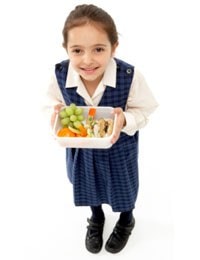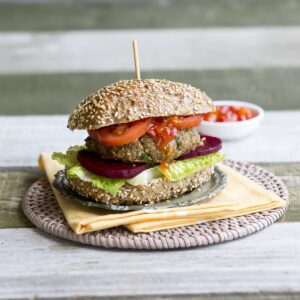
It’s back to school time – an occasion for tears and nostalgia (for parents of new entrants) and just a teeny bit of relief (for most other parents). It’s also time to get back into the routine of preparing school lunches.
To help kids grow up strong and healthy, develop strong bones and muscles and perform well at school, it’s important they get the nutrients they need from their food. Getting a wide variety of food across the whole day is key. The school lunch is an important part of that day; a great lunch gives kids the fuel and brain power they need to get through the school day.
So what’s in an ideal lunch box? Think of it like a jigsaw with five pieces.
1. Wholegrain carbohydrates
This includes bread, of course, but don’t forget wraps, flat breads, grainy bread rolls and grainy crackers. If your kids normally reject grainy breads, try using one slice of white and one slice of grainy bread in a ‘rainbow’ sandwich, to gradually introduce the idea.
2. Protein
Protein-rich foods provide a number of key nutrients for kids, including calcium and iron. This includes dairy, which provides important calcium, so cheese sticks or slices, yoghurt and flavoured long-life milk are all nutritious choices. You can make high-protein sandwiches with fillings such as lean ham, chicken, peanut butter, tuna or hard-boiled eggs.
Tip: Keep foods like meat and dairy cool (important for food safety) by packing a bottle of frozen water in the lunchbox. Or freeze yoghurt tubes or fruit and vege juice to keep the lunchbox cool; they’ll thaw out by lunch time. Just remember to wrap frozen items in a couple of paper towels or something similar to soak up the condensation as they melt, otherwise food will go soggy and they won’t eat it!
3. Vegetables and fruit
Fresh fruit and veges are so important, but they can be a tough sell in a lunchbox when there are more interesting treats on offer. Cutting whole fruit into manageable pieces or more appealing fruit salad can help. Try a small container filled with berries, apple and melon pieces, or frozen grapes. Don’t forget stewed and dried fruit also count towards their fruit servings. Veges like cherry tomatoes or carrot and cucumber sticks can go down well, especially if paired with a hummus or cheese dip.
4. Snacks
Packaged snacks are convenient, but not all are ideal, nutritionally. What’s more, lots of schools now have a ‘no rubbish’ policy, meaning all packages have to come home again. If you can, aim to provide no more than one packaged muesli bar or snack item each day and try to choose wholegrain and dairy-based snacks. By providing just a few packaged snacks each week, kids won’t feel they’re missing out.
5. Fluids
The best drink for the lunchbox is water. For most kids the drink bottle is just as important as the drink inside, so let them choose their own. And try freezing it – children are more likely to drink fluids when they’re cold.
www.healthyfood.com










